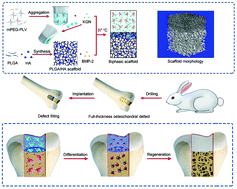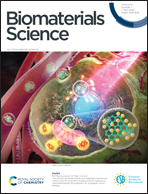Bionic biphasic composite scaffolds with osteochondrogenic factors for regeneration of full-thickness osteochondral defects†
Abstract
Full-thickness osteochondral defects lack the capability to self-repair owing to their complicated hierarchical structure. At present, clinical treatments including microfracture etc. have shown some efficacy; however, the newborn tissue exhibits some drawbacks, such as fibrocartilage formation and insufficient mechanical properties, eventually leading to osteoarthritis. Moreover, cartilage and bone tissues have different biological characteristics. Therefore, the simultaneous repair of full-thickness osteochondral defects is highly challenging. To achieve optimal repair, we constructed a bionic biphasic composite scaffold with on-demand osteochondrogenic factors. Kartogenin and extractive mesenchymal stem cells were introduced into a mPEG-block-poly(L-valine) thermogel set as the upper layer to accelerate cartilage repair. A poly(lactide-co-glycolide)/hydroxyapatite porous scaffold was immobilized with bone morphogenetic protein-2 as the bottom layer to facilitate subchondral repair. The intermediate interface, being a combination of the two layers, was expected to reconstruct the calcification zone. Gross evaluation, micro-computed tomography, and magnetic resonance imaging indicated that at 6 months after implantation, the scaffold encapsulating mesenchymal stem cells and osteochondrogenic factors had a better effect compared with other groups. More importantly, the composition of the new cartilage and bone was confirmed by western blotting, H&E staining, immunohistochemistry, and immunofluorescence. Taken together, this bionic composite scaffold with osteochondrogenic factors offers a promising option for the repair of full-thickness osteochondral defects.

- This article is part of the themed collection: Biomaterials Science Recent HOT Articles


 Please wait while we load your content...
Please wait while we load your content...